In 1987 Battersea Power Station was destined to be the world’s greatest theme park. We publicly unveil the original plans for the first time ever…
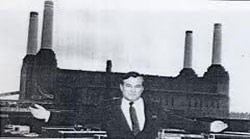
Back in the 1980's things were cool. It was cool to be a stockbroker, a banker, even a hedge-fund guy. Greed was good and things were going swimmingly. Ambition, enthusiasm, determination, drive and unwavering confidence were all celebrated, encouraged and, crucially, rewarded. If you were intelligent enough, focused enough and were willing to work hard enough you could drive that banana yellow Lamborghini Countach down the King's Road with pride. Sure, there were all sorts of people who were more intelligent, academic and astute but they didn't choose that particular path and can therefore not complain. But it was all there for the taking and it inspired a generation. Live and let live.
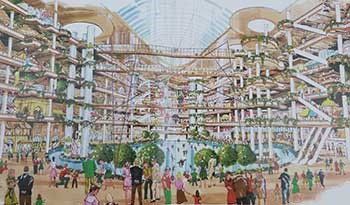
What's more, back then you could dream. And not only could you dream but you could also do things, which today would be ridiculed as 'not financially viable' (meaning it won't make an instant profit because a Russian or Middle Eastern guy with loads of cash to rinse can't buy five hundred square feet of it for ten million quid – not that I have anything against foreign money, it’s great, I just think it’s a shame it’s mostly in property). In those days, a great idea with a great plan and a great track record (Alton Towers was a testimony to all of the above) was supported by the banking world, the Government and, most of all, the public who were not quite so jaded or cynical. Now the banks would only support such a project if you could personally guarantee every penny you dared to borrow. Well, if you could do that you wouldn't really need to borrow it in the first place, would you?
Yes, banks these days want to have their cake and eat it. In the ’80s, there was a crucial difference. They wanted to have their cake but accepted that sometimes it would end up smeared all over their greedy wild-eyed faces!
It was all about risk and reward. Now it's all about minimizing risk (and squashing reward because we're taught to be almost ashamed of financial success). It's bollocks - I'd take the 80's any day! Live and let die!
Battersea Power Station (or, 'The Battersea' as it would have been known) was one such dream - a vision which was almost thirty years ahead of its time. Fact.
Looking at the plans this weekend (in my father’s shed) it struck me that, had these plans been proposed today, they would have been received as 'the next generation of inner-city entertainment and retail concepts - like the (utterly brilliant) Westfield Centre. On acid!'
Broome wins Battersea Power Station!
In 1988, my father announced his plans to the world stating "When I first walked inside this monster of a building, it's magnificence overwhelmed me. Unlike most immense buildings, the more you stared, the larger it grew. Only private enterprise could take on a challenge like this, to restore it and give it a rebirth". He continued "We're putting the fun back into London as its one of the very few capital cities in Europe without its own major entertainment complex. It fills me with great pride to know that I am taking on something so wonderful, so colossal, so unique!" He then, rather fatefully concluded "The Battersea will open in 1990, the culmination of seven years of meticulous planning, to generate excitement, thrills, fun and pleasure in a safe weather-proof environment. A new Palace of Entertainment for London!"
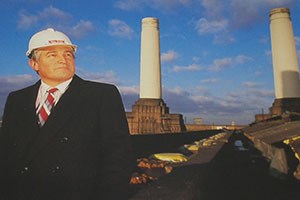
It all came about years earlier when my father won a competition to buy Battersea Power Station, launched by the UK Government, and personally Championed by Margaret Thatcher who, as we all know, loved a good old ‘Wolf of Wall St.’ style entrepreneur (rumour has it, intimately, and my father doesn't deny that either (pillow-talk was the possibly far fetched joke back in the day!)). Ultimately, however, it was Lord Ezra who handed him the contract, which got the adventure underway. Indeed, dad became good friends with the PM, which resulted in dinners at No.10 with George Bush Snr. amongst many other Heads of State and dignitaries over the years. His vision for the world's most hi-tech theme park, supported by his fiercely loyal crack team of global professionals, aristocrats, designers, architects, surveyors and technicians, really was the most exciting development on earth. And, looking at the plans for the first time in decades it would still be, without a doubt, today.
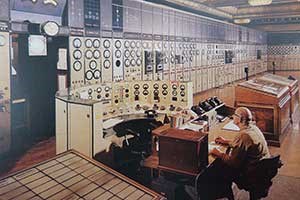
Spearheading the entire development project was an American Legend, Michael A. Jenkins. Mike, as head-honcho of his groundbreaking agency, LARC (Leisure and Recreation Concepts) is still to this day the world leader in theme park conceptual design, having worked very closely with Disney and having built many of the world's finest parks, including Alton Towers.
Mike moved his entire senior team (including himself) to London for this project, which was undoubtedly the biggest in the world at the time. We’re still lifelong friends with Mike, and his brilliant son, Angus, is now a prominent figure at Chance Rides - one of the US's leading ride and roller-coaster manufacturers - it's in the blood! So, in the unlikely event, you're building a theme park, you'd better call LARC because they’re the magic behind the magic!
Why didn't it become a reality?
But first, what actually went wrong and why didn't this magical concept ever become a reality? It was an awesome idea, right?
There's a clue in the fact that the building has stood empty and decaying for almost thirty years. That's because nobody in their right mind was going to touch it. I can't tell you how many times I've read journalists' arrogant accounts of 'what should have happened' or how 'John Broome f**ked it up'. Indeed, every time a new property development scheme was rumoured to be on the cards the London papers would come out all guns blazing. Well, that's ridiculous and completely un-credible from people who spend their life writing about the rise and fall of others with absolutely no intention or desire to do anything about it themselves – it was a regular Evening read and it became Standard (if you see what I mean!?).
I remember one such story naming me and my sisters as well as publishing our home address, presumably because they wanted someone to blame? It's extraordinary to me that whereas the headlines once screamed "Mr. Fun comes to London to build the greatest entertainment complex on Earth', they now scream (equally triumphantly) 'Battersea Power Station to be transformed into Luxury flats'. Well, whoopy-do!
That’s just what London needs. More 'luxury flats'. Everybody wins. Except for anyone who's not the actual developers of course! Wake up world! This is a tragic consequence of one track minded confirmative blandness!
But, life sometimes sucks and a few things went wrong:
1) There was the small matter of the last big recession hitting in the early '90s. Believe it or not, but the value completely and unequivocally fell out of the London property market (unheard of in this day and age, I know). I've heard stories of people losing 50% of the value on their Battersea flats over-night at the time, which puts it in stark perspective. If something worth £150k was suddenly worth £75k, what was Battersea Power Station's devaluation going to look like?
2) Security Pacific Bank (you've never heard of it because it doesn't exist anymore, at least partly due to my dad!) went bust. And they'd pledged about £200m to the project which suddenly wasn't there anymore. Try replacing that in a hurry.
3) No matter what any purists say, Sir Giles Gilbert Scott, the celebrated architect, wasn't as clever as he's often credited to be. Not on this one anyway. The foundations weren't deep enough, nor were they sound enough for such a colossal building on the banks of a river. It was the biggest brick building in the world (St.Paul's Cathedral would fit comfortably inside it) and once the machinery was ripped out, a task which took over a year due to the phenomenal amount of lethal Asbestos cladding involved, it transpired that much of this machinery was doubling up as artificial foundation material.
Removing the asbestos
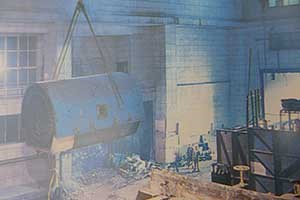
If nothing else, my dad should be credited with making the world’s biggest and potentially most lethally air polluted building plot into a safe site for Londoners to live in close proximity to, as well as paving the way for the current developers who would not have touched it with a barge pole had somebody not dared to do the dirty work for them all those years ago. And as for those who enjoy saying that he took the roof off and couldn't afford to put it back on, then you're welcome too. Taking the dangerous, decaying and Asbestos- clad roof off and underpinning the entire building is exactly what has preserved it for thirty years whilst several developers have tried and failed to do absolutely anything whatsoever with it, however un-inspiring their plans may have been.
Despite what some journalists like to say, there should be a Walt Disney style statue of the guy right at the entrance because his years of hard work (and money) is why that building still stands today.
Local residents protest
In fact, after selling Europe's most successful visitor attraction in a hurry (that's Alton Towers) my father famously stood in front of the Power Station on national TV and pledged his last £26 million to the project when the rest of the world was slipping off the edge of a cliff (or, at best, hiding behind the sofa!). There was another somewhat unhelpful spanner in the works too and that was a militant local residents’ movement who were (until surprisingly recently, according to their website) hell-bent on scuppering the whole plan because it would have been 'disastrous' for their property values and livelihood to have the world’s greatest mecca of entertainment in their back yard, employing tens of thousands of people and bringing more wealth (not to mention transport) to the area than a hundred Olympic games run constantly and simultaneously, forever. Yeah, right! Ironically, on the morning my father so passionately and defiantly claimed that The Battersea would open its gigantic engraved bronze art-deco Power Station doors (31st May 1990, I seem to remember) rubber-stamped by a personal visit from the Iron Lady herself, the local residents' association had dramatically scaled the building and daubed in gigantic letters "BROOME AND THATCHER OUT!" along an entire South face - quite impressive really, and certainly a compliment to be so publicly vilified – 'Bring It On' is our family motto!
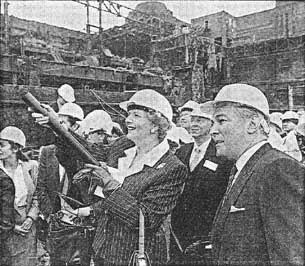
You win some, you lose some...
As it happens though, Battersea was, alas, slipping into the Thames even faster than the economy and he lost the lot.
But fair play, you win some you lose some. He did lose about £500 million, Alton Towers, a couple of other theme parks, a 200-acre country estate, a Stately Home, A yacht, a helicopter and several million pounds worth of art and antiques though – oh, and his last £26 million, of course, which wasn't great.
So that's essentially what went wrong, but it was much closer to happening than anybody knows. The glass elevator shafts were on site, the entire design team had decamped from Dallas, Texas and were housed within the Power Station. The entire building was gutted and ready to go. I remember meeting the guys who had just designed the mine-train set for Indiana Jones and the Temple of Doom, which epitomized the sheer scale of the project and the aura that surrounded it.
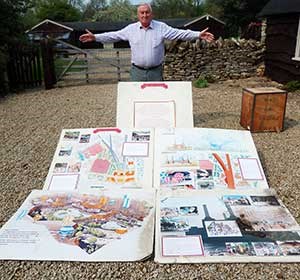
As I've discovered this weekend whilst helping my parents move house (and when I say 'helping' I actually mean poring over the wealth of Battersea plans I've uncovered in the process) this place was going to be the greatest place on earth and I don't care who you are (or what you think that you think) you would have agreed, had it comes to fruition! I also remember a filing cabinet in the Control Room (that cool, fully intact art-deco room in ‘Turbine Hall A’ which you can see in Monty Python's 'The Meaning of Life'), filled to the brim with open-ended first class rail tickets. Literally thousands of them which were there for the taking as the team frequently travelled up to Stafford from Euston between Battersea and Alton for inspiration, I presume (and perhaps to absorb uber-inspiration from the 30,000 or so daily visitors who flocked to possibly the most inaccessible location in the nation (much to the dismay of our equally industrious family friends and neighbours, the Bamfords of JCB fame, who didn't entirely appreciate the daily queue of coaches on the road to their Staffordshire estate - which is somewhat understandable, but success always takes a few prisoners!). In fact, this is possibly one of the reasons why they de-camped to Daylesford in The Cotswolds which is, ironically, where my parents have ended up too...
My dad, of course, didn’t really do rail or roads by this stage. He mostly flew in his Bell 222 helicopter, which was modestly emblazoned with the Alton Towers and Battersea logos (often with a 15-year-old me at the controls - I very nearly crashed it once, but that’s a story for another time). Oh, there was an AV room in the Power Station too, a theatre in which the most prominent 'Dr. Who', Tom Baker's formidable 'voice of God' boomed over the sound system to ram this massive project into the ear-holes of anyone who would listen, to ensure it was ringing in their ears for all eternity!
And I'm convinced it would have changed the face of the events industry too. There was to be a huge, state of the art exhibition hall, two conference centres and a multitude of awesome event spaces that were all integral to the plans. I genuinely believe it would have replaced the need for Excel and yet it would have been situated in Central London, surrounded by the world's greatest retail outlets, entertainment, simulators, Imax theatres, roller-coasters and even on-site accommodation. Literally, better than Vegas.
The Battersea would be the Holy Grail of the leisure, exhibitions, events, retail and amusement park worlds. Disney, Westfield, Excel and Soho all rolled into one magical site at the heart of the world's most vibrant city.
It was a one-off opportunity and we blew it.
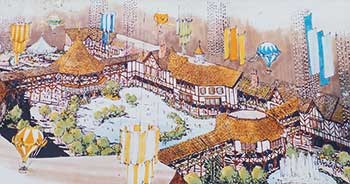
All aboard 'The Battersea Bullet'
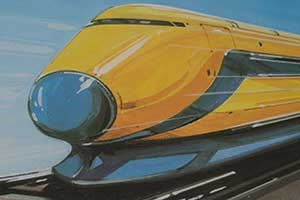
What very few people know is that The Battersea was also ahead of its time in terms of CSR and sustainability. Indeed, the super hi-tech 'Battersea Bullet' overland electric train would have linked Victoria Station with The Battersea site - negating the need for protracted deliberations over the proposed Northern Line extension, which continue to this day.
My father had even taken a long lease out on Victoria Station's prominent Platform One (any other platform would simply not have been prominent enough!) Interestingly, (although fairly typical), he claims that he still 'owns' the rights to the 'Battersea Bullet'. Remember my recent article about arriving in style? Well, check out the storyboard description of this aspect of the Battersea experience:
"The Battersea Bullet, manned by British Rail drivers and Guards in special branded uniforms, will leave at eight-minute intervals for the three and a half minute journey. Windowless trains with wrap-around video screens will give passengers the illusion of travelling at supersonic speed. Personal touch-screen display units, installed in every seat-back, will enable visitors to call up the daily programme of events and a description of the rides and restaurants, to help them plan their day at The Battersea".
Excuse my gratuitous French but this was nineteen-eighty-fu**ing eight! He was always great with awe-inspiring names too. I remember sitting around the kitchen table as a child when he came up with the best roller-coaster name of all time – ‘The Thunder-Looper’ which people all over the world still remember! It was subsequently sold to a theme park in Brazil after a decent stint at Alton Towers (there’s a huge underworld in trading roller-coasters because they’re expensive!) It was predicted that 52% of the 5.6 million annual visitors would arrive by the Battersea Bullet. There was also to be 2,243 parking spaces and a river bus via the new piers (way before people dreamed of using river-buses).
Interestingly, although being fairly central from a google maps perspective, Battersea has always seemed a little awkward to get to. It's one of those rare transport black-spots where you always end up walking (seemingly for miles) to get to wherever you're going. Well, this scheme, amongst other things vowed to make Battersea a place 'where the Southbank meets the West End'. That alone would have enhanced the area enormously over the past thirty years with a legacy stretching far beyond the lifespan of the aggressive local objectors.
Welcome to “The Battersea” - step into a magical world...

Typical of my father's meticulous (almost OCD) nature was his insistence on opening with such a forthright Welcome statement "The surroundings will be spotlessly clean, the smiles genuine, the service swift and efficient and seven thousand guests will pass smoothly through our turnstiles every hour of every day". Our very own Willy Wonka - right on!
"When you walk through the ornate glass lobby into the main gallery at Battersea, the sheer size of the building will take your breath away. The main hall, open to the ceiling, will soar up past five tiers of galleries, each with its own entertainment theme, to an airy skylight, where a back projection will show what time of day it is and what the weather is like outside". I guess like the brilliant Forum Shopping Centre at Caesar’s Palace in Vegas?
"The vast atrium space will be a fusion of inside and outside environments with trees, climbing plants and a giant waterfall at the north end of the hall, which guests will be able to walk behind". Most importantly of all, it would feed the giant Crystal lake, which would to this day have been the largest ice-skating rink in Europe. At the time there were only four ice-rinks in London so, yet again, this was decades before its time based on the present-day popularity of Ice skating in the UK, certainly at Christmas.
Accentuating the vastness of the turbine hall, the hot air balloon ride (yup!) would take guests right up to the roof and float them back down in colourful, turn-of-the-century balloons.
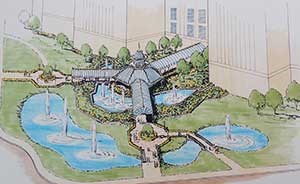
Guests were to be entertained in queues and anti-chambers by live, themed entertainers and video shows so you’d never feel like you were standing in line at The Battersea – queuing was so 1980!
Each floor would represent a different Continent with shops, restaurants, IMAX theatres, hi-tech rides, simulators, even authentic ethnic staff, all meticulously 'on theme'. Rides were to cater for all ages too - from play areas for toddlers to sensationally stimulating teenage 'white-knuckle' rides such as the menacing 'Magic Room' which would basically have been the same as the popular 'Hex' rotating room at Alton Towers - but twenty-five years earlier!
The Lost Rides...
There were to be over forty major rides and attractions inside The Battersea including 'Gravitron' - basically a flying saucer using centrifugal force to simulate the sensation of flying through space, 'Space Probe' which blasts your space capsule up to the roof through a glass tube (for all to see) before free-falling from the entire height of the building and 'Trabant', a sort of twisty, tilty thing spinning off its own centre of gravity and giving riders a sense of zero gravity. A sensational array of gondola driven 'Dark Rides' and roller-coasters would complete the diverse array of world-beating rides.
London's own Tivoli Gardens
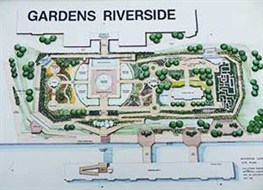
London's most beautiful landscaped gardens (see Alton Towers' gardens for proof of that fact) would line the 680 ft. Thames riverbank, replacing the derelict coal store that remains to this day. The gardens were to take on a 'Tivoli Gardens' theme, creating a year-round festival atmosphere, which, at night, would come alive with millions of twinkling 'Tivoli lights'.
The extensive pleasure gardens were to be a place for Londoners to stroll, day and night, policed by park rangers and the twenty-four hour Battersea security staff.
Most importantly of all, these gardens would have been free to Londoners at all times, to be used as a beautiful and vast recreational landscaped park.
The incredible rides that could have been
External rides included the 'Jumbo Jet Coaster' which was a fast and furious ride, bespoke to The Battersea and darting in and out of the ground creating a sense of bewilderment via lasers, lighting, special effects and music to enhance the experience - a true world first and a bit like the awesome Aerosmith ride at Disneyland Paris. Again, twenty-five years in advance.
Other outside rides included the 'Rapids Ride' based on the success of one of the most popular rides at Alton Towers (I remember driving around that ride in my grandpa’s Range Rover whilst it was being built), the 'Flying Island' designed to soar at 200ft and, of course, the timeless classic (remember I mentioned the Indiana Jones set builders were on site?) Runaway Mine Train, which would be very similar to the movie, racing through ravines, caverns, mine shafts, even waterfalls - oh, it would have been F-ing spectacular, with a capital “F”!
The biggest Oceanarium on earth

But the thing that would really have set The Battersea apart would have been the super hi-tech and innovative infrastructure and edu-tainment which was integral to this incredible project. The Oceanarium, for example, would have been the biggest on Earth, covering the entire footprint of the Power Station, underground. The USP of this vast aquarium was to re-create the sensation of 'diving without getting wet'. A moving walk-way would transport guests along with a transparent tunnel, twisting its way around the Oceanarium ‘sea bed’ without viewers ever being able to see the edges of the tank. For the more adventurous, mini submarine rides would enable explorers to roam the World's tropical waters more freely.
The London dark ride
Another topical highlight was the 'London' dark ride, which was to be, effectively, a history lesson in disguise. Beginning amidst the London fog, journeying through time and discovering the heritage and evolution of the world's most culturally diverse city, this was anticipated to be hugely popular with the millions of international visitors who were expected at The Battersea – a sort of glorious initiation to London life…
In-theatre simulator rides
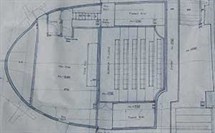
The Haunted Theatre, the Motion-Master Theatre and the Dynamic Motion Theatre were all uber hi-tech experiences utilizing the very latest in commercial airline simulator technology whereby the entire theatre moved on hydraulic 'rams'. Guests would 'enjoy' a heart-stopping ride as the action sequences on 3D wrap-around screens would be synchronized with hydraulically actuated theatre seats. The seats themselves were to be programmed to produce a vertical translation, roll, pitch and even jar effects.
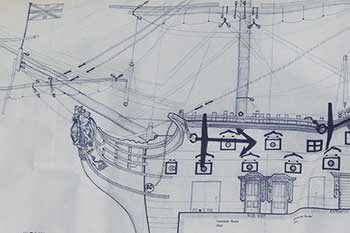
The Exploratorium
Then there was The Exploratorium, which was to be the world's most hi-tech, interactive children's experience where younger guests could create virtual electronic line sketches with light pens, activating light shows which would respond to the pitch and modulation of their voice (amongst other things which I equally don't understand!).
Around the world in a 'Battersea Day'
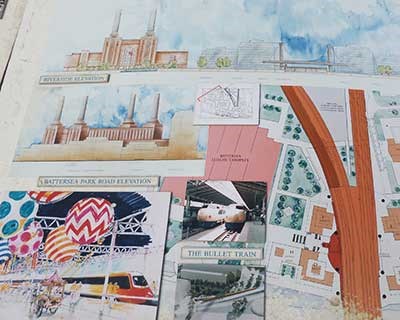
The Battersea would also have been a super-modern take on the Great Exhibitions of old - a sort of EPCOT World Showcase in a high-rise. With authentic cultural experiences from around the world, spanning some 30,000 square feet on every floor of this immense cathedral of cultural and technical innovation, from the restaurants, where the brilliantly coined 'In the mood food' was designed to reflect the cultural realities of the continent the guests were on, to the entertainment, the rides, the stage shows, the decor, the staff - all authentically themed. Retail 'greatest hits' include the bustling 'Chinese Emporium' where guests could buy everything from silk shirts to hand-painted china to bamboo ware and bean sprouts. Damn, this place was a Wholefoods market too! Australasia included educational rides and experiences teaching visitors about the cultures of Maoris and Aborigines as well as catering for the rest of us with beach-babes and surfer dudes manning the takeaway joints. Sort of Abercrombie. Before Abercrombie.
The Battersea was to be a Mecca of entertainment (open until 2 am, 7 days a week) from pure high-octane family fun to fine dining and (literally) everything else in between. All the fresh food produce was to be collected daily from Smithfield, Billingsgate and New Covent Garden Markets - not Brakes Bothers. 22% of the floor space was set aside for retail, 57% for rides - like Westfield in reverse. And just as Westfield has 'The Village' for ultra up-market shopping, The Battersea was to have its own 'Designers Alley' and 'Bond Street Boutiques' selling brands from Cartier to Gucci...
The stark reality in the late 1980s was that the theme park market was static. And mostly outdoors. It was universally suspected that large-scale indoor entertainment complexes, fusing entertainment, shopping and leisure were the future. And this was the global prototype. Even Disney was watching very closely.
Conferences, Events and Exhibitions
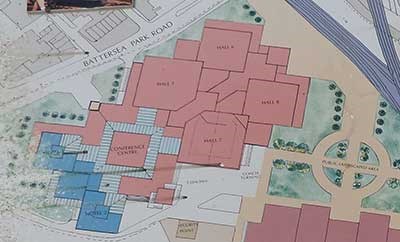
Believe it or not, in 1988, there was no decent sized conference venue in London with world-class facilities. A main hi-tech corporate conference auditorium/theatre would seat 700 and a secondary 400 seated theatre would also be available for smaller conferences. In addition to that, 12 further meeting rooms would seat up to 100 delegates each. Interestingly, at the time, research showed that exhibitions were not very popular in the UK, at least compared to the Continent but evidence pointed to the fact that emerging hi-tech industries were creating a market for the exhibition industry. It was believed that, due to its underlying hi-tech foundation, The Battersea would attract a huge number of conferences and exhibitions, especially as the latest in innovative presentation technologies would be universally available as standard.
And finally...an immense restoration
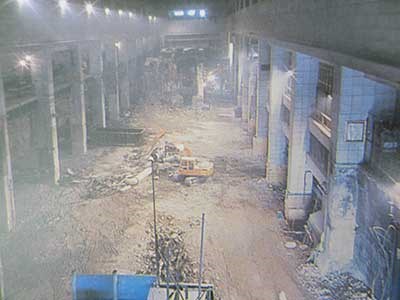
Nowadays, most people never knew the awe-inspiring plans my father dreamed up for ‘The Battersea’ or, if they did, they certainly didn't know the extent of it. Rather than dwelling on the ultimate failure of the project (which is somewhat inevitable, I know), what people with an opinion should focus on is the sheer scale of restoration that was carried out:
The biggest asbestos removal programme of all time.
Securing the entire site.
Replanting and reconstruction of the boiler house.
Underpinning of a one million square foot building.
Shoring up of the gigantic listed facade.
Replacing hundreds of thousands of bricks, from the same source (Etruria Marl) and using the same manufacturing process as the original 1933 building.
Replacement of the steelwork in the giant 'gas washing' towers.
All completed. At immense expense, I might add!
The Battersea concept pushed boundaries of entertainment, technology, transport, sustainability, retail, innovation, education, fine dining, disability access, even licensing - it would have been utterly awesome and would have remained, to this day and beyond, the UK's answer to Walt Disney World, right in the heart of one of the biggest and best cities on Earth.
And then, of course, there was our family penthouse. A gigantic glass palace on the roof with Batman-style search-lights mounted on each of the fluted chimneys and, naturally, an up-lit heli-pad for G-JLBZ! Well, there has to be a dash of Bond baddie megalomania somewhere in there doesn't there? Come on!
"Showmanship is a vital, but intangible, ingredient of a successful leisure park. People come to a leisure park to enter a different world, where they can leave their everyday cares behind. Originality, inspiration, adventure, fascination, nostalgia, illusion, music, colour, cleanliness and thrill combine to create that essential theme park experience"
John Broome CBE.
He's not dead, by the way. He's actually on the cusp of a dramatic comeback...
Will Broome
A few of my favourite Battersea Power Station Facts
- The Chimneys stand 337 feet high (103 metres)
- The building could 'swallow' a 22-storey building (and St.Paul's Cathedral)
- There is a one million square ft. interior space
- Nottingham City Centre would fit inside (my favourite Battersea Fact!)
- Over 8 million bricks were used in building the Power Station
- 'When completed, The Battersea will comfortably cater for 22,000 guests at any one time'
- Sir Giles Gilbert Scott was also the inventor of the classic Red Telephone Box. So we inherited hundreds of them, which we got rid of, presuming they were ‘worthless’! *Well, who uses a phone box?